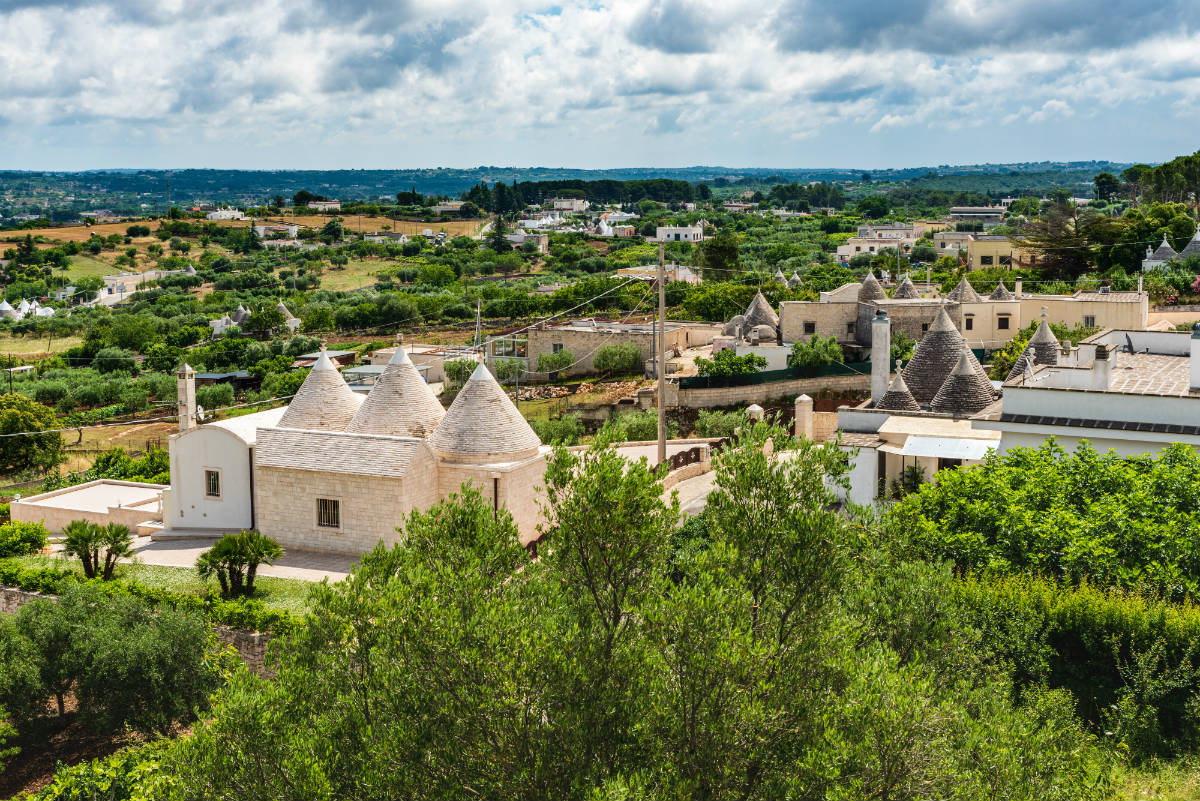Salento, Gargano, Tavoliere delle Puglie and Valle d'Itria are some of the geographical areas that best represent, in their own way, the essence of the Apulia Region. In particular, the Itria Valley perhaps best encapsulates the characteristics of this beautiful land, including verdant landscapes, a paradisiacal coastline, jewel-like villages and a wine and food heritage waiting to be discovered.
Itria Valley: historical background
The Itria Valley is that area nestled between the Southern Murge, the province of Taranto, the province of Brindisi and the Metropolitan City of Bari: it is a vast depression of karst origin that offers visitors spectacular landscape views, where vineyards, olive groves, almond trees, Mediterranean scrub and dry stone walls alternate.
Itria Valley is a land where history, folklore and legend come together, having been the crossroads of many peoples throughout its history, from the Messapians to the Greeks to the Romans to the Goths and Lombards. Its name has uncertain origins: perhaps it refers to the cult of Our Lady Odigitria imported by the Basilian monks or probably from the native cult to St. Mary of Hydria. In the past, about a hundred million years ago, this valley was nothing more than a seabed, later emerging in part and becoming a land of dinosaurs, many traces of which have been found near Ceglie Messapica. The presence of the first humans dates back to about 20 million years ago, as shown by the findings that can be seen today inside the Ostuni Archaeological Park.
Itria Valley: what to see
The Itria Valley is a true treasure chest of beauty, with picturesque villages, among which one cannot fail to mention Alberobello, which has moreover been declared a UNESCO World Heritage Site: its historic center is in fact composed exclusively of trulli, the enchanting conical constructions with gray roofs, which make Alberobello in the same way as an enchanted town. One cannot help but be enraptured walking through the uphill alleys of Rione Monti, among the Siamese Trulli and the Church of St. Anthony of Padua, always strictly trullo-shaped. After enjoying the most beautiful view of Alberobello from the terrace in Gian Girolamo d'Acquaviva Square, you can reach the nearby Castellana Caves, one of the most beautiful wonders in all of Europe: they are about 3 kilometers long, in a riot of stalactites, stalagmites, canyons and marvelous chambers such as the Grotta Bianca completely made of alabaster.
Then among the most beautiful villages in the Itria Valley is Martina Franca, the territory's Baroque pearl that has its beating heart in Piazza Roma, where the 17th-century Ducal Palace stands. A must-see is the beautiful Basilica di San Martino in Piazza Plebiscito, stunning with its white marble facade: inside you can admire paintings of the Neapolitan school from the second half of the 1700s.
A stone's throw from Martina Franca then rises the Bosco delle Pianelle, a nature reserve where it is possible to walk among oak groves, holm oaks and Mediterranean scrub, with the opportunity to also spot hares, hawks and barn owls.
Then Locorotondo, among the most beautiful villages not only in the Itria Valley but in all of Puglia, is worth seeing: it clings like a spiral on a rise, with its tall white houses with pointed roofs called Cummerse, from which there is a spectacular view of the entire Itria Valley. The Church of San Giorgio, the Church of the Madonna della Greca and the Clock Tower are worth a visit.
You can't say you've visited the Itria Valley without stopping then in Ostuni, the "white city" that rises on three hills, on the edge of Alto Salento: its historic center called La Terra, is a real beauty, between the 15th-century Cathedral, the remains of the Castle and the interesting "Museum of Preclassic Civilizations and Southern Murge."
Itria Valley between festivals, crafts and good food
Getting to know the authenticity of the Itria Valley also means discovering its gastronomy, and there are plenty of dishes that will leave a mark on visitors: think, for example, of Alberobello's pork-based bombette, donkey meat chops and especially gnummareddii, meat rolls with innards that are enjoyed on the grill. In Locorotondo in the summer there is the Sagra degli Gnumeredde Suffuchete, with these tasty rolls cooked in broth. Then try lampascioni, or strictly wild onions, orecchiette pasta with turnip tops and capocollo di Martina Franca, which is marinated in Vincotto. How can we not then mention the excellent wines of the area, in particular Martina Franca DOP and Locorotondo DOP white wine.
Those, on the other hand, who are looking as souvenirs to take home some handicrafts, well, in Valle d'Itria they will be spoiled for choice: in fact, it is possible to buy baskets made of woven rushes, lace, objects made of olive wood and, above all, ceramics, in the characteristic balloon or pumo shapes, that is, a rosebud with an auspicious meaning.
Events in the Valle d'Itria
Villages in the Valle d'Itria
In the heart of the Murgia dei Trulli, 50 kilometers from Bari, a graceful ex...
Cisternino, one of the pearls of the Itria Valley, is also known for the qual...
Locorotondo is the most beautiful balcony in the Murgia dei Trulli. It is cha...
The White City of Ostuni is the most popular seaside town in Puglia, characte...













